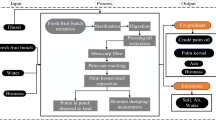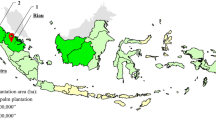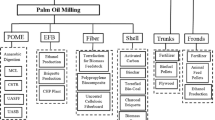Abstract
Purpose
Palm oil systems generate substantial amounts of biomass residues which are, according to best agricultural practices, preferably returned back to plantation in order to maintain soil fertility. However, there are often variations in this practice. Differences in economic status and possible treatment options for biomass residues determine the preferences to perform life cycle assessment (LCA), leading to a divergence in results. Difficulties when comparing LCA results based on literature are not unusual. The objectives of this paper are to provide guidelines for methodological choices that enable a systematic comparison of diverse scenarios for the treatment and valuation of empty fruit bunches (EFBs) and to explore effects of the scenarios on the environmental performances of a palm oil system.
Methods
Eleven scenarios were selected to address the possible EFB valuation and expanded boundaries with reference to the main palm oil system (EFBs applied as mulch, converted to compost or ethanol, treated in an incinerator, and sold as coproducts). The life cycle inventories were modeled based upon an Ecoinvent database. Solutions to multifunctional problems were suggested, including the application of system expansion, substitution, and partitioning, depending upon the nature of the scenarios.
Results and discussion
Comparison among LCA results based on the same multifunctional units (crude palm oil + palm kernel oil + palm kernel cake) can be accomplished only in cases where additional coproducts were utilized internally. Based on the global warming impact, the mulch option was preferred. The effect of the avoided process of producing synthetic fertilizers and the assumption that all parts of mulch are available as soil nutrient dominantly determined the final result. These need further verification. This study also demonstrates that the status of EFB as waste or goods is influential on the final results if the EFB is employed externally but has no effect if it is utilized internally.
Conclusions
The proposed guidelines provide methodological choices in terms of system boundary, functional unit, and solutions to multifunctional problems. The methods can be used to systematically compare LCA results of different treatment options and valuation of EFB. The preferred alternative for managing this biomass residue could improve environmental performances and orient toward best practices, such as those suggested by the Roundtable on Sustainable Palm Oil (RSPO). Further studies incorporating a site-specific case of palm oil systems would better illustrate the usefulness of the proposed guidelines.



Similar content being viewed by others
References
Bellon-Maurel V, Aissani L, Bessou C, Lardon L, Loiseau E, Risch E, Roux P, Junqua G (2013) What scientific issues in life cycle assessment applied to waste and biomass valorization? Editorial. Waste Biomass Valor 4:377–383
Caliman JP, Suhardi, Pujianto (2013) Impact of by-products recycling on soil quality. In: Webb MJ, Nelson PN, Bessou C, Caliman JP (eds) Proceedings of workshop: sustainable management of soil in oil palm plantings, Medan, 7–8 November 2013.
Chiew YL, Shimada S (2013) Current state and environmental impact assessment for utilizing oil palm empty fruit bunches for fuel, fiber and fertilizer—a case study of Malaysia. Biomass Bioenergy 51:109–124
Doka G (2003) Life cycle inventories of waste treatment services. Ecoinvent report No. 13. Swiss Center for Life Cycle Inventories, St. Gallen
GAPKI (Indonesian Palm Oil Association) (2013) http://www.gapki.or.id/Page/CPOPrice?Index=7&selectedPage=0. Accessed 13 October 2013
Guinée JB, Heijungs R, Huppes G (2004) Economic allocation: examples and derived decision tree. Int J Life Cycle Assess 9(1):23–33
Guinée JB, Heijungs R, van der Voet E (2009) A greenhouse gas indicator for bio-energy: some theoretical issues with practical implications. Int J Life Cycle Assess 14(4):328–339
Hansen SB, Olsen SI, Ujang Z (2012) Greenhouse gas reductions through enhanced use of residues in the life cycle of Malaysian palm oil derived biodiesel. Bioresour Technol 104:358–366
Haron K (2013) Sustainable nutrient management in oil palm ecosystem. In: Webb MJ, Nelson PN, Bessou C, Caliman JP (eds) Proceedings of workshop: sustainable management of soil in oil palm plantings, Medan, 7–8 November 2013
Heijungs R (2014) Ten easy lessons for good communication of LCA. Int J Life Cycle Assess 19(3):473–476
Heijungs R, Frischknecht R (1998) A special view on the nature of the allocation problem. Int J Life Cycle Assess 3(5):321–332
Heijungs R, Guinée JB (2007) Allocation and “what-if” scenarios in life cycle assessment of waste management systems. Waste Manag 27(8):997–1005
ISO (2006) Environmental management—life cycle assessment—requirements and guidelines (ISO 14044). International Organization for Standardization, Geneva
Jungbluth N, Chudacoff M, Dauriat A, Dinkel F, Doka G, Faist Emmenegger M, Gnansounou E, Kljun N, Schleiss K, Spielmann M, Stettler C, Sutter J (2007) Life cycle inventories of bioenergy. Ecoinvent report No. 17. Swiss Center for Life Cycle Inventories, Duebendorf
Koh LP, Ghazoul J (2010) Spatially explicit scenario analysis for reconciling agricultural expansion, forest protection, and carbon conservation in Indonesia. PNAS 107(24):11140–11144
Kusdiana D (2013) Existing and new bioenergy policies needed and implementation target. Paper presented at EBTKE Conference and Exhibition 2013, Ministry of Energy and Mineral Resources of The Republic of Indonesia, Jakarta, 21–22 August 2013
Laurance WF, Koh LP, Butler R, Sodhi NS, Bradshaw CJA, Neidel JD, Consunji H, Vega JM (2010) Improving the performance of the roundtable on sustainable palm oil for nature conservation. Conserv Biol 24(2):377–381
Lee KT, Ofori-Boateng C (2013) Oil palm biomass as feedstock for biofuel production. In: Sustainability of biofuel production from oil palm biomass, Springer, Singapore, pp 77–106
Lim S, Lee KT (2011) Parallel production of biodiesel and bioethanol in palm-oil-based biorefineries: life cycle assessment on the energy and greenhouse gases emissions. Biofuels Bioprod Bioref 5:132–150
Nemecek T, Kägi T (2007) Life cycle inventories of agricultural production systems. Ecoinvent report No. 15. Swiss Center for Life Cycle Inventories, Duebendorf
MPOB (Malaysian Palm Oil Board) (2012) Economics and industrial development division. www.mpob.gov.my. Accessed 3 February 2012
Salétes S, Caliman JP, Raham D (2004) Study of mineral nutrient losses from oil palm empty fruit bunches during temporary storage. J Oil Palm Res 16:11–21
Sheil D, Casson A, Meijaard E, van Noordwijk M, Gaskell J, Groves JS, Wertz K, Kanninen M (2009) The impacts and opportunities of oil palm in Southeast Asia. CIFOR, Bogor
Singh LA, Pant D, Korres NE, Nizami AS, Prasad S, Murphy JD (2010) Key issues in life cycle assessment of ethanol production from lignocellulosic biomass: challenges and perspectives. Bioresour Technol 101:5003–5012
Stichnothe H, Schuchardt F (2010) Comparison of different treatment options for palm oil production waste on a life cycle basis. Int J Life Cycle Assess 15:907–915
Stichnothe H, Schuchardt F (2011) Life cycle assessment of two palm oil production systems. Biomass Bioenergy 35:3976–3984
Tuck CO, Pérez E, Horváth IT, Sheldon RA, Poliakoff M (2012) Valorization of biomass: deriving more value from waste. Science 337:695–699
Wardenaar T, van Ruijven T, Beltran AM, Vad K, Guinée J, Heijungs R (2012) Differences between LCA for analysis and LCA for policy: a case study on the consequences of allocation choices in bio-energy policies. Int J Life Cycle Assess 17(8):1059–1067
Wiloso EI, Heijungs R (2013) Key issues in conducting life cycle assessment of bio-based renewable energy sources. In: Singh A, Pant D, Olsen SI (eds) Life cycle assessment of renewable energy sources. Springer, London, pp 13–36
Wiloso EI, Heijungs R, de Snoo GR (2012) LCA of second generation bioethanol: a review and some issues to be resolved for good LCA practice. Renew Sustain Energy Rev 16(7):5295–5308
Yusoff S (2006) Renewable energy from palm oil—innovation on effective utilization of waste. J Clean Prod 14:87–93
Acknowledgments
Financial support from the Netherlands Fellowship Programs (NFP) for EIW is gratefully acknowledged. Appreciation is given to Indonesian Institute of Sciences (LIPI) for providing an opportunity for EIW to pursue a PhD study at Leiden University. The authors would like to thank the French National Research Agency (ANR) for the field trip support to Sumatera, Indonesia, within the frame of the SPOP project (http://spop.cirad.fr/) Agrobiosphere program. We also would like to thank Lauran van Oers of CML, Leiden University, for assisting with the CMLCA software and Bayuaji Kencana for useful information on palm oil biomass residues. The comments and suggestions from two anonymous reviewers are highly appreciated.
Author information
Authors and Affiliations
Corresponding author
Additional information
Responsible editor: Greg Thoma
Electronic supplementary material
Below is the link to the electronic supplementary material.
ESM 1
(PDF 113 kb)
Rights and permissions
About this article
Cite this article
Wiloso, E.I., Bessou, C. & Heijungs, R. Methodological issues in comparative life cycle assessment: treatment options for empty fruit bunches in a palm oil system. Int J Life Cycle Assess 20, 204–216 (2015). https://doi.org/10.1007/s11367-014-0815-1
Received:
Accepted:
Published:
Issue Date:
DOI: https://doi.org/10.1007/s11367-014-0815-1




